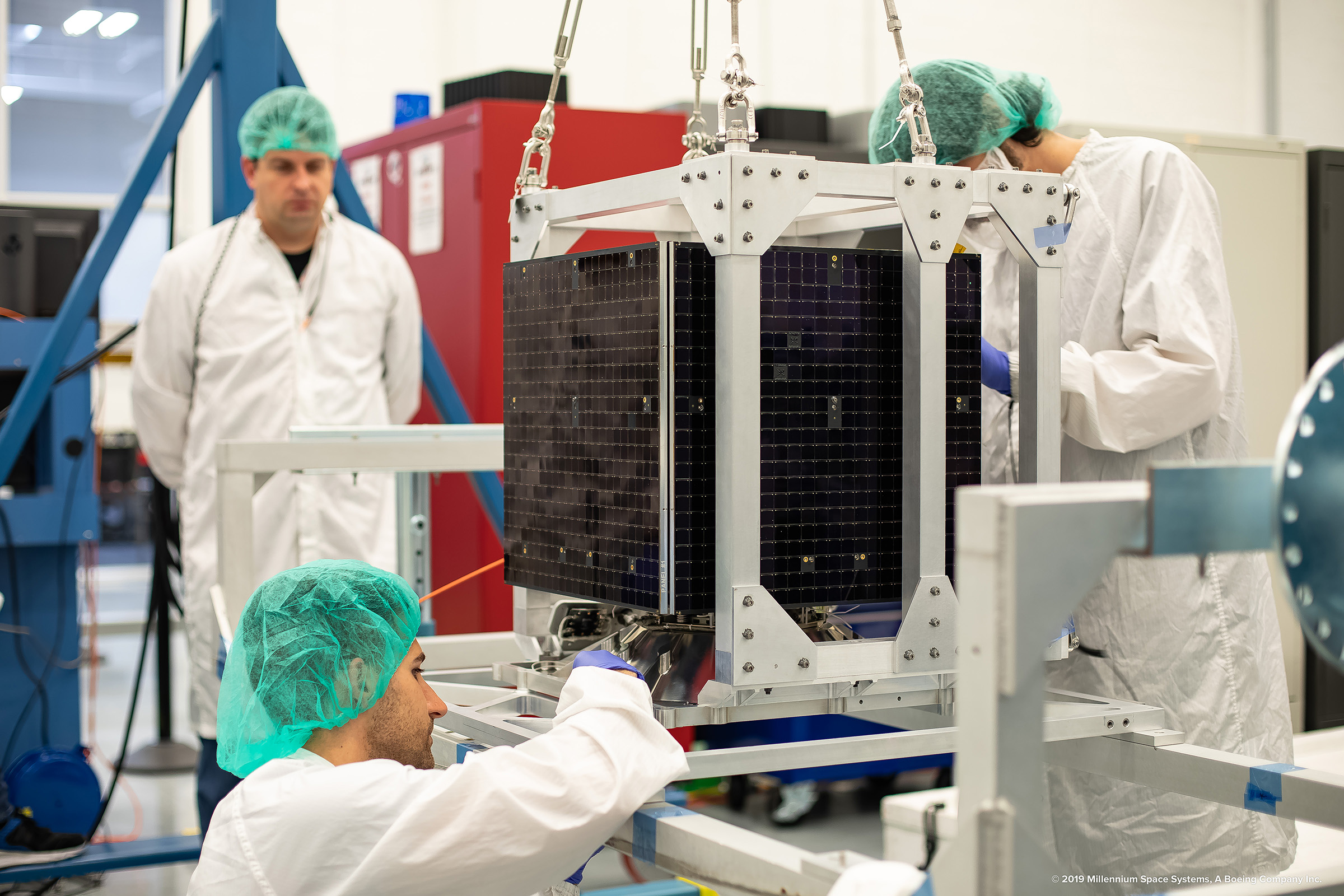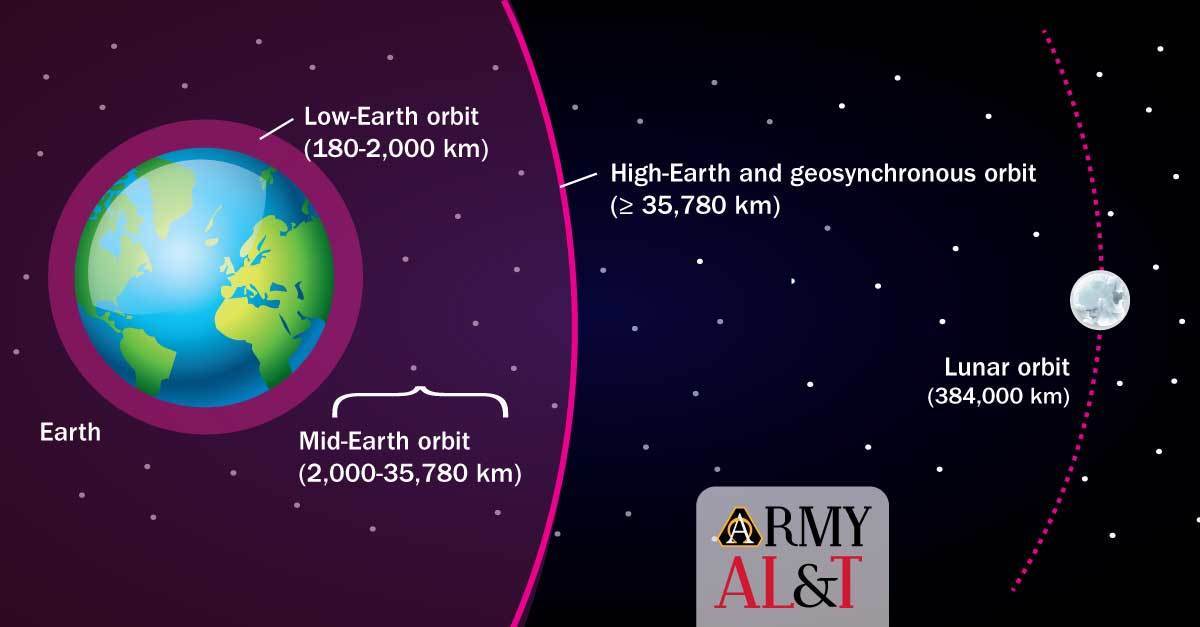BARRY ROSENBERG

The Space Force’s Satellite Communications Enterprise Management and Control (SATCOM EMC) program is the Defense Department’s strategy for melding military, commercial, and coalition satellite communications capabilities found in orbit (LEO), medium-Earth-orbit (MEO), and geosynchronous orbit (GEO). It’s part of a strategic pivot away from the Global War on Terrorism (GWOT) to the Great Power competition against China and Russia and all-domain operations.
In this Q&A with Mike Dean, chief of DoD SATCOM, we discuss the value of developing capabilities in low-Earth orbit, how payment models for SATCOM are changing, and a status report on SATCOM EMC.
Breaking Defense: How is the military using SATCOM today, compared to how it was used at the height of the GWOT?
Mike Dean, Chief of DoD SATCOM.
Dean: Today we’re still relying heavily on traditional, transponded satellite communications with wide swaths of coverage beams. In the past, we’ve enjoyed relatively uncontested use of that kind of capacity, which was nice from a command and control perspective — whether it was airborne ISR or voice communications on the ground.
We’re starting to see that space getting more congested and contested. We don’t necessarily enjoy the ability to lay down a big coverage beam. We also have terrestrial providers that are now competing for greater swaths of the spectrum, as well as adversaries that are starting to have more sophisticated impacts in spectrum, in space, and in cyber.
Then there are the new, disruptive technologies that are being developed as we’re
bringing the orbits closer into Earth. Where we used to rely on geosynchronous-centric communications that could tolerate latency — we would save low-latency applications for aerial- and terrestrial-based comms — we’re starting to see a shift where the DISN services that ride over our DoD Information Network are going to be able to break from their terrestrial confines and move out into space. Because of that, we’re seeing a greater reliance on, or increasing use of, subscription services.
Folks are starting to use SATCOM for applications that previously they weren’t able to do because of the latency. During my time in the 82nd Airborne Division, there were sometimes communication sessions that we couldn’t do on our transponded SATCOM because the session would break because it couldn’t handle the latency once you went over a couple of hops. That’s the biggest change.
The environment is also changing because of both commercial and adversarial competition in the trade space. In addition, we have new warfighting applications for capabilities in SATCOM that we weren’t able to use before.
Breaking Defense: I interview a lot of senior industry executives and their companies are heavily invested in figuring out ways to network their legacy systems through DevSecOps software development to quickly create JADC2-type capabilities. Is that how you view SATCOM EMC, as a construct that tries to meld existing military and commercial systems?
Dean: I think it’s actually more than that. One of the main pushes for enterprise capabilities, which led to our push for enterprise SATCOM command and control, is that we had traditionally siloed capabilities — whether it was by spectrum, by the ground control network, or by particular orbits.
Now, because of JADC2, we don’t have the luxury to operate in those silos. We have to be able to allocate SATCOM capability and bandwidth globally where and when it’s needed. To support that, you need more than just having interoperable systems. You have to automate your resource allocation processes to where you can turn around allocation of capacity on a dime. So automating certain processes that were not automated in the past is one of the key drivers behind that.
The second piece is situational awareness and common operational picture. I always like to say that there’s no such thing as a common operational picture because everybody needs to see their own set of information. For example, an operating center in Space Command wanting to determine what its information requirements are in SATCOM might be interested in what the enemy is trying to do to them, or what they are doing to themselves through electromagnetic interference.
I need to be able to take information from multiple sources, put that together, and then create a fused picture so that I can decide and act and improve my OODA loop. As we look at JADC2 and the C2 component of multi-domain operations, it’s all about speeding up your OODA loop.
If I can rapidly visualize what’s going on in my SATCOM enterprise through multiple sources, whether it’s spectrum or cyber, I can then decidedly act. Once I make that decision, then the resource allocation process has to be automated so that I can know what services I have out there.
Let’s say I’m being jammed in one band and I have a customer that needs to continue to communicate. I’m able to see across the enterprise and say, yes, this service doesn’t necessarily meet this requirement anymore because the enemy’s doing X, Y, or Z. I can now move them over to another service. But I have to have the situational awareness to know what services are available at that time and space to make that transition.

New, disruptive technologies for low-latency applications are being developed for low-Earth orbit. (NASA illustration by Robert Simmon).
Breaking Defense: The ability to transmit/receive data on the move is key for all-domain operations and Joint All Domain Command and Control (JADC2). The need for comms on the move has been worked on since the days of WIN-T (Warfighter Information Network-Tactical) since around 2010. Is on-the-move communications going to be easier to accomplish today and how is it going to be different in an all-domain environment?
Dean: In an all-domain environment you’re trying to connect sensors to shooter across the battlefield. Those kinds of applications, again, are very low latency. You have to make decisions at machine speed. You can’t make those kinds of decisions at a halt or at a pause, which is traditionally what we relied on SATCOM for. Or if you’re using narrowband, you’re still mobile but have a very low data rate. You might be able to send some short data bursts, but you can’t really do a lot of C2 on the move with your narrowband capability beyond voice.
But now in this new JADC2 environment, again, you have these applications, whether you’re doing targeting or threat detection, for which you don’t have the luxury of halting your platform, erecting a C2 node, and establishing the communications. You have to do it on the move.
We used to have this chart that we drew in the Army that was the cycle of C2. You’d be at your command post and you’d have access to your WIN-T or your operational networks. But once you move from one firebase to the next, you’re all of a sudden detaching, and you’re going voice only. Your situational awareness drops from up here down to the bottom. And then you’re steadily trying to get that back while you’re on the move, but you never quite get back to where you were when you were connected to your node.
That’s why we’re excited about some of these disruptive technologies that are coming out in non-GEO orbits (like LEO) that are closer in for low-latency communications. Now we can actually have access back to storage and processing capabilities so we don’t have to erect our own version of AT&T on the ground and do processing there at the site. We can actually use the cloud to reach back, have access to that processing, and then make those C2 decisions on the move.
That’s the difference (today) in being able to transmit and receive on the move; it’s doing it with the right volume and the right latency so that you can execute those tactical applications.
Breaking Defense: Earlier you mentioned subscription services. How does the DoD pay for SATCOM today, and how would it like to see payment options evolve?
Dean: We’ve got two modes. Traditionally we had military purpose-built SATCOM where someone like DISA would be paying for the teleports, the large gateways. The services would pay for their terminals, and they would carve money out of their appropriated budget for some mission-specific capability that they needed to employ for their particular service-centric mission.
For commercial SATCOM, the services would go through the commercial SATCOM office using their operating funds to procure additional bandwidth they needed that maybe wasn’t satisfied by military purpose-built [SATCOM].
We’re starting to see that model change. You saw when the DoD moved the commercial procurement office from DISA to Space Force. That’s a reflection that we understand that those two things can’t be separate because we see SATCOM as something that should be an integrated enterprise. That was the first signal of where we’re going.
We are seeing how we pay for our contracts and commercial SATCOM. The transponded bucket was how we used SATCOM in GWOT. You’re starting to see that get a little bit smaller, and starting to see subscription services for end-to-end managed services become more used by the services.
The commercial SATCOM office at Space Force is actually looking at an initiative where they’re going to transform how commercial SATCOM is procured. Ms. Clare Grayson (chief of Space Force’s Commercial Satellite Communications Office) calls it the central pool of SATCOM with different types of capabilities.
I look at it like a waterpark; there’s not really one pool. When you go to Wet ‘n Wild you have a Lazy River, which is one service. And you might have another service, which is a Tornado.
But it’s going to be a managed service; I know that’s where they’re headed. You’re going to see the trend go less from, hey, give me a traditional transponded slice of capacity that I’m going to use for my service, to a managed service that all the services use. That’s going to drive down cost and probably be more effective, and it’s going to fit into this enterprise model.
Breaking Defense: I know you’re rolling out your enterprise SATCOM vision now but I’m wondering what v.2 of that might look like, as well as what organizations like DARPA are working on for future SATCOM?
Dean: The predominant theme at Satellite ‘21 was proliferated LEO; that’s the disruptor. You’re looking at programs like DARPA Space-BACN (Space-Based Adaptive Communications Node that connects LEO constellations with optical datalinks) and the Space Development Agency’s Tranche LEO as low-latency transport to do some of those military applications I was talking about earlier. That is obviously going to reshape the landscape of what we’re going to do down the road in 5, 10 years as we start launching all these satellites.
However, there’s also a lot of disruption going on in the other orbits, MEO and GEO. Looking at what we’re doing with enterprise SATCOM management command and control, we recognize that the landscape is going to change and if you’re going to be resilient you’ve got to be everywhere. You can’t just be in one or two orbits; you’ve got to be in all the orbits.
And you’ve got to be in both military and commercial. In military, we have certain niche ways that we do things like protection or mobile operations with UHF. But commercial has different ways to do that. So being able to recognize that there are different techniques and procedures to do certain military applications is going to be a huge benefit for us.
Then we need to be able to integrate all those capabilities across a hybrid orbit — meaning military and commercial and heterogeneous in all the different orbits. Being able to operate and manage an enterprise that has those kinds of capabilities is what’s going to get us the next technological and operational advantage that we’re looking for JADC2.
The other big effort we have to do is shape our terminals. I’ve heard someone say that it’s the dog that wags the SATCOM tail. We have a ton of them with many different types from different procurement agencies. They’re heavily integrated into weapon platforms, so when you have to modernize them it’s really difficult. So we’re working on a reference architecture that’s going to try to help standardize these terminals and specify certain interfaces and protocols so that we can make them more interoperable and enterprise friendly.
To pull that back to what we’re doing with enterprise MNC, we see that as the management layer that allows you to integrate all those capabilities together and effectively use them.
Breaking Defense: So what’s the latest with enterprise MNC and the roadmap going forward?
Dean: We’re in the final stages for the enterprise management and control reference architecture that we published in December 2019. So it’s already official. We are working on an implementation plan, which is our plan to execute and deliver the solution architecture that is going to actually do the modernization. That is in final staffing and we’re looking at sometime in the next quarter to try to get that signed and issued out to the force.
We need three things for the roadmap. We need that terminal reference architecture that I talked about to shape the terminals. The enterprise management and control implementation plan is going to commoditize certain IT services at the enterprise level. We’ve identified those in the reference architecture, and they deal with mobility, electromagnetic interference, resource allocation, authoritative data catalogs, integrated management, and the network interface so we can plug in internationally partnered networks and commercially managed services.
That’s the main thing that we’re solving with the solution architecture for enterprise management and control, and we have a phased approach to add those capabilities.
Along with the implementation plan, you have to modernize your technical capability because it doesn’t do you any good unless you also automate your process. It’d be like putting new windshield wipers on a busted-down truck with no engine or wheels. We’re relying heavily on the operational community as part of this plan to go through their resource allocation process, their mission management process, and how they do things today, and then modernize that to match the new reality of the enterprise model.

No comments:
Post a Comment